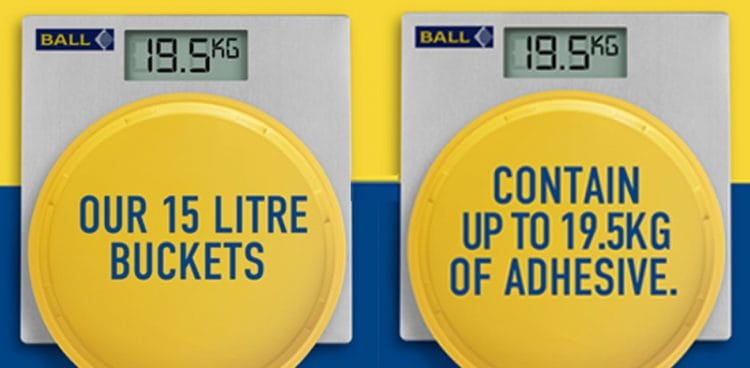Kilos v Litres – A Buyers Guide

While the appearance and longevity of flooring installations are primary concerns for flooring contractors when making purchasing decisions, the need to keep an eye on costs means that value for money cannot be overlooked. When it comes to adhesives and considering how much product you get for your money, the distinction between volume and weight is critical.
In recent years, there has been a trend towards stating quantities on product packaging by weight (i.e. kilos) rather than the standard UK measurement, which is volume (litres). While there is nothing wrong with this per se, there is the chance that it could be inadvertently misleading for contractors who might equate volume with weight. In fact, a given number of litres of an adhesive will often give a significantly greater volume than the same number of kilos of the product because of its relative density.
Worked example
F. Ball’s Styccobond F58 PLUS fast-drying, fibre-reinforced, pressure sensitive adhesive for LVTs provides a good demonstration of the volumetric difference between adhesives sold by similar numbers of litres and kilos. Styccobond F58 PLUS is available in 15L and 5L units, but 15 litres of the product weighs 17.25 kg, over 20% more than similarly packaged products sold by equivalent weight. The difference will depend on the density of the particular adhesive and in certain cases a 15L unit of an F. Ball adhesive equates to around 19.5kg. A difference well worth considering.
The problem can be exacerbated by similarly sized packaging. Visually, buckets may not appear to be too different in size, but there can be a stark difference in what’s inside, and contractors may lose out financially.
Coverage rates
This is important because adhesives are applied by volume, not weight. Ensuring the correct amount of adhesive is applied is critical for achieving adequate bond strength, and flooring contractors will find that 15 kg of product will generally cover less surface area than 15 litres of product. If too little adhesive is used, it may not deliver the required bond strength throughout the life of the installation, potentially leading to floor failure. Apply too much and it can extend the drying time of the adhesive or mean that they fail to dry properly, also reducing bond strength. Furthermore, excess adhesive may seep through carpet floorcoverings and cause bleeding at joints and indentations to appear in sheet floorcoverings.
If two containers of adhesive (one litres and the other kilos) are being sold at virtually the same price, as is often the case, it means that you are getting significantly less product for your money from the product that is sold in kilos. Perhaps even worse, it could give contractors the impression that they are getting the correct amount of adhesive they require for an installation while leaving them short.
Rigorous testing
The production of F. Ball’s annual Recommended Adhesives Guide (RAG®), which details the compatibility of all of the company’s adhesives with over 6,000 floorcoverings produced by over 200 manufacturers, allows contractors to make an informed decision about which specific adhesives to use with particular floorcoverings.
Recommendations only make it into the RAG® if F. Ball’s technical service department can be sure that the adhesive will perform for the entire lifetime of the floorcovering after the completion of a rigorous seven-week testing programme at F. Ball’s state-of-the-art testing facilities and subject to endorsement by the relevant floorcovering manufacturer. Criteria for measuring bond performance of adhesives with floorcoverings is based on British Standards. Tests measure initial grab, as well as bond performance over time, with temperature used to simulate the effects of ageing.
Additionally, the RAG® app, which is free to download from the Apple App store or Google Play, provides a way to work out exactly how much adhesive that you will need for a particular project – a handy product coverage calculator, also available on F. Ball’s website. The same coverage calculator can be used to work out how much of an F. Ball smoothing compound or waterproof surface membrane will be required for an installation based on subfloor area.
For the avoidance of doubt, when one adhesive is sold in kilos and another is sold by the same number of litres, the product sold by volume will almost always offer better value for money where the two are similarly priced.
